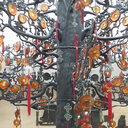Breast cancer resistance protein-mediated efflux of luteolin glucuronides in HeLa cells overexpressing UDP-glucuronosyltransferase 1A9.
Mots clés
Abstrait
OBJECTIVE
UDP-glucuronosyltransferases (UGTs) are responsible for the formation of glucuronides of polyphenolic flavonoids. This study investigated the UGT1A9-mediated glucuronidation of luteolin and the kinetics of luteolin glucuronide efflux.
METHODS
HeLa cells overexpressing UGT1A9 (HeLa-UGT1A9) were used to determine the kinetics of breast cancer resistance protein (BCRP)-mediated transport of luteolin glucuronides. Human UGT isoforms were used to determine glucuronidation rates.
RESULTS
UGT1A9 was found to catalyze the production of four luteolin glucuronides, including three known monoglucuronides and a novel 3', 4'-diglucuronide. Ko143, a potent specific inhibitor of BCRP, significantly inhibited efflux of luteolin monoglucuronides from HeLa1A9 cells and increased their intracellular levels in a dose-dependent manner. The formation of luteolin diglucuronide was observed when intracellular concentration of total monoglucuronides went above 0.07 nM.
CONCLUSIONS
Intracellular accumulation of diglucuronide was detected at high monoglucuronide concentrations (>0.07 nM). Diglucuronide production is speculated to be a compensatory pathway for luteolin disposition.




